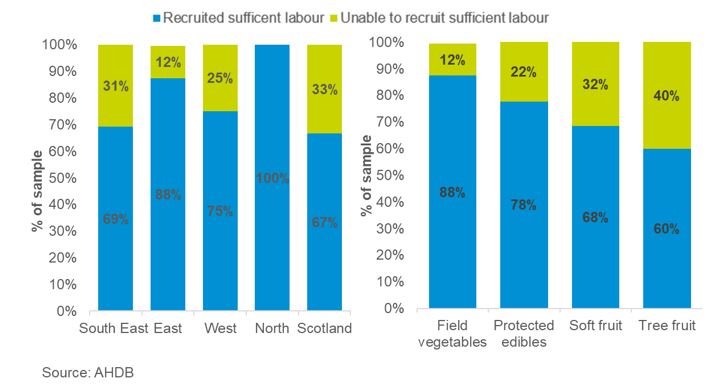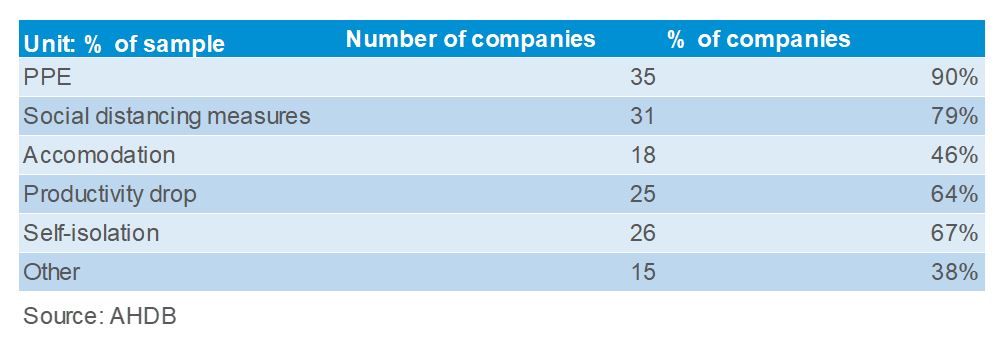Please click here to access the main AHDB website and other sectors.
- Home
- Horticulture Labour Barometer
Horticulture Labour Barometer
The Horticulture Labour Barometer provided information on real time labour requirements from a sample of edible horticulture producers in England and Scotland from end-May to end-September 2020. The edible horticulture sectors sampled are field vegetables, soft fruit, tree fruit and protected edibles. The aim of the Horticulture Labour Barometer is to provide industry and Government with independent evidence to establish the reality of the impact that COVID-19 is having on labour availability.
Introduction
This release covers the results of the Horticulture Labour Barometer wrap up questions from the end of the 2020 harvest period.
In total, 42 edible horticulture producers opted in to contribute to the Horticulture Labour Barometer. When asked in the week ending 29 May, this sample of growers require approximately 23 thousand seasonal workers in total this year. A breakdown of contributors by sector and by region is shown in the table below. Please note the sector total is greater than the total number of contributors as some businesses in the sample grow crops for more than one sector. From the end-May and end-September between 37 and 42 companies and cooperatives submitted a response to the weekly/ fortnightly questions. At the end of the 2020 season, all those who opted in were sent a set of wrap up questions for the season, where upon 39 companies and cooperatives submitted a response. The wrap up questions aim to provide an overview of how COVID-19 has affected horticulture producers in 2020.
Total number of contributors by sector and region
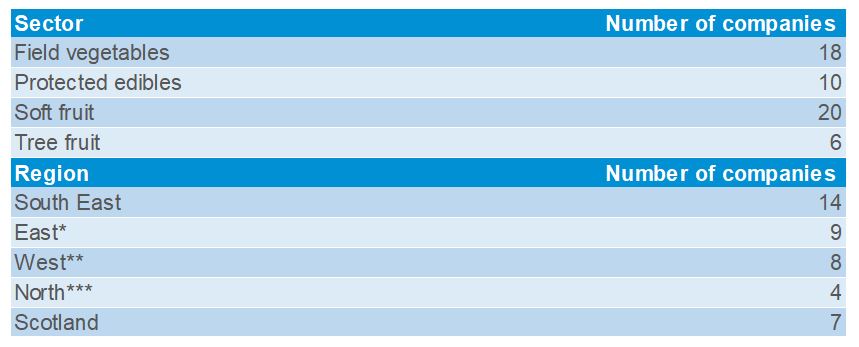
*East (East of England and East Midlands), **West (West Midlands and South West), ***North (Yorkshire and North West)
Labour Requirements
When asked how would you describe your experience with seasonal labour recruitment this year, 23% of companies said that they were unable to recruit a sufficient amount of labour this season to meet their productivity targets.
Breaking this information down by region and the data shows that the South East and Scotland had the largest proportion of growers not able to recruit sufficient labour respectively. Likewise, companies that grow soft fruit and tree fruit had a higher proportion of companies that did not recruit enough workers (Figure 1). However, it is important to note that less companies grow tree fruit than other sectors.
Figure 1: Proportion of companies recruiting a sufficient amount of labour for the season by sector and region
When comparing with previous years, 67% of companies who submitted a response said that they had a higher turnover of workers in 2020. All growers who responded from Scotland said they had a higher turnover, with 31% in the South East saying they had retained sufficient labour throughout the whole season (Figure 2).
Figure 2: Proportion of companies retaining a sufficient amount of labour for the season by region
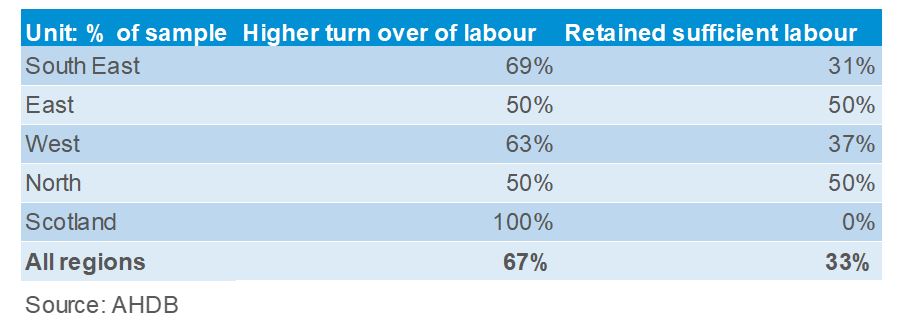
Out of the 39 companies who submitted a response, 64% (25 companies) said that they had employed more local workers in 2020 compared with previous seasons (Figure 3).
Figure 3: Proportion of companies employing more local workers in 2020 compared with previous years by region
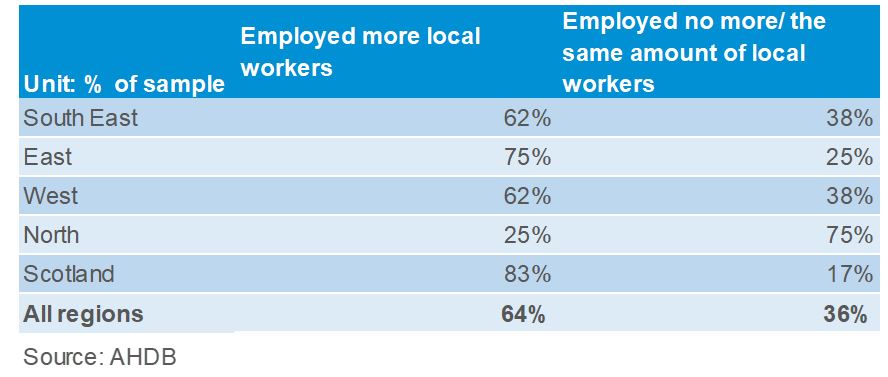
When asked about the productivity of local workers employed in 2020, 90% of companies said that local labourers were less productive than overseas workers. This was particularly prevalent in the North and Scotland, with 100% of companies in both regions saying overseas workers are more productive (Figure 4).
Figure 4: Productivity of local workers compared with overseas workers by region

Out of the 25 companies who said they employed more local workers this season, 72% said that employing more local workers had an effect on overall productivity for the business. When asked to explain why overall productivity was lower due employing more local labour, the majority of companies citied the following reasons:
- Less crop is harvested per hour than overseas workers
- Local workers required more training
- Higher turnover of local workers
- Local workers found the job harder and more tiring than overseas labour
Figure 5: Proportion of companies that experienced an effect on overall productivity from employing more seasonal labour
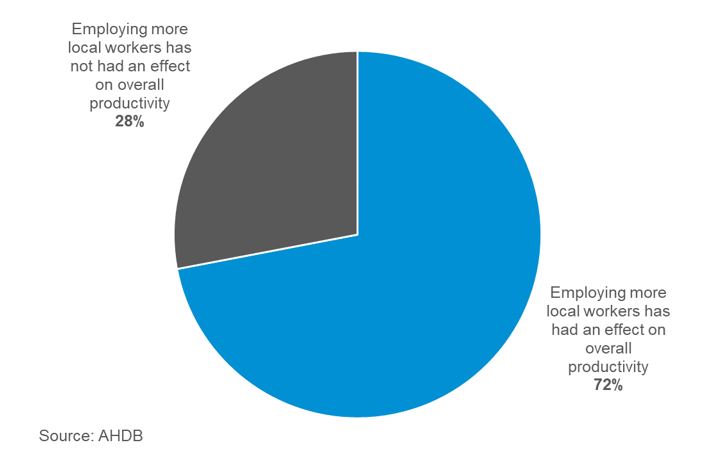
Cost of Covid-19 on businesses
When asked what the biggest challenges of the 2020 season were for their business, the majority of growers cited one or more of the following explanations:
- Covid-19 restrictions/health and safety measure i.e. social distancing, isolating staff etc
- Staff retention/ higher staff turnover
- Reduced ability to recruit overseas workers
- Adverse weather
Contributors were asked whether they have managed to identify any opportunities as a result of their experience over the past year. The majority of growers who gave a response identified one or more of the following opportunities:
- Improve induction processes
- Better recruitment processes are needed
- Improved communication methods
- Development of training resources
All 39 companies who submitted a response said that they had experienced additional costs in the season due to COVID-19. At the time when asked, eight growers were unable to quantify the extra cost at that point in time. However, the remaining 31 companies gave us an estimate of the additional costs of COVID-19 on their business which totalled £6.78 million.
When asked where in the business these additional costs occurred, 90% of companies said PPE, with 79% also attributing social distancing. Figure 6 shows the areas in which companies experienced additional costs. For those companies that answered ‘other’ intense hygiene protocols, chartering flights, extra training, overtime, reduced sales and more facilities (i.e. hand washing stations) all contributed to additional costs for these businesses.
Figure 6: Areas that led to additional costs
Review of labour market barometer
All contributors were asked whether they found the labour market barometer a useful exercise in providing real time data for the season and 95% of those said they did. Likewise, 95% of companies said they would like to see it being run again next year (Figure 7).
Figure 7: Review of labour market barometer

For further information please contact the team directly via our helpline on hort.labour@ahdb.orguk or Tel: 024 7527 1600
Get involved
If you are an edible horticulture producer and would like to take part in the Horticulture Labour Barometer you can sign up directly via our helpline on hort.labour@ahdb.orguk or telephone: 024 7527 1600. The team is available to answer and questions that you may have. All information provided is kept confidential, with all results aggregated and anonymised before release.
Contact the coronavirus helpdesk
- Email: coronavirus.helpdesk@ahdb.org.uk
- Call: 02476 019361


